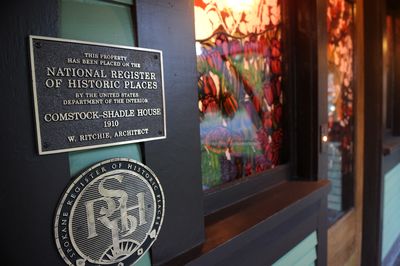Simple details
Patty, Jerry Dicker strive for perfection while preserving Comstock-Shadle house

At times, the exhausting restoration of Patty and Jerry Dicker’s historic Spokane residence was as prickly as the roses they picked to accent their Tudor Revival home.
The couple, California transplants, were shopping for local office space when they toured the South Hill brick and stucco house, which had been converted into six tiny apartments.
It was built in 1910 for influential local merchants James and Elizabeth Comstock, proprietors of the Crescent Department Store.
After the Comstocks died, the house passed to their daughter, Josie, and her husband, Eugene Shadle.
The Dickers worked to have the Comstock-Shadle house included on the National Register of Historic Places. Today, it’s one of four similarly styled houses built for the two Spokane families between 1905 and 1918.
As a self-professed fan of the flowery Victorian era, Patty Dicker admits she “had trouble falling in love with the house,” which has strong Craftsman underpinnings.
In the process of bringing the house back to its original splendor, she grew to appreciate its clean, simple lines and occasional embellishments.
“It’s a nice airy feeling so you don’t have to stuff the rooms with furniture,” she says.
She also managed to incorporate the roses she loves into the home’s décor. Among the places they’re found are light fixtures, ceramic wall hangings and lamp globes.
The roses are most stunning in the foyer, where they cascade across a floor-to-ceiling glass front door panel and the pair of windows flanking it. Vines and leaves also are sandblasted into the glass, lending a 3-D appearance.
Sherry Boyd-Yost, a Spokane County glass artist, created the show-stopping windows in her studio. Dicker said by combining the two artistic techniques, “Sherry’s done the gamut of what you can do with glass. She was exploring a new frontier.”
Local metalsmith Alex Robinson, who renovated several historic fixtures in the Fox Theater, also joined the creative team.
Perhaps his crowning contribution is a fireplace screen adorned with four delicate-looking metal roses. He also refurbished the home’s nearly 100 year-old light fixtures and made strong metal frames to secure the decorative glass panels in the foyer.
Meanwhile, the cleared rubble began to reveal the home’s 15 original rooms, including a conservatory, butler’s pantry and maid’s quarters. Pocket doors, substantial crown moldings, built-in bookcases and cabinets, remnants of antique light fixtures, paneled walls and hardwood floors were uncovered and restored.
In the thick of it, Dicker slipped on a step and broke her foot.
She didn’t let it slow her down. Instead, she spent her down time researching turn-of-the-century architecture and furnishings.
“You do start to get a feel for what’s ‘right’ for the times,” she says.
Then, she began shopping Internet sites for 1910-era chandeliers, shades for sconces, replacement tiles and other items. “I did dip a bit into the 1920s,” she added with a laugh.
“The Internet is just fantastic for this. It opens up the world to you,” she smiles.
She drew inspiration for wall colors from painted lamp globes and ceramic pieces from the time period. Warm tans, mauves, greens, lavender and blues landed on the interior’s color palette.
In the kitchen, the homeowners struck a restoration compromise, adding an island and modern appliances. They maintained the room’s integrity by having the original cabinets refinished and leaving exposed a bit of the brick chimney through which the old wood cook stove would have been vented.
But every improvement seemed to beget another, Dicker said. As the work dragged on and costs mounted, she sometimes grew impatient, she says.
“You feel you can’t go ahead, and you can’t go backward,” she laughs. “You want the pain to end and the bills to quit rolling in, but then you just plow ahead. You suck it up, and you spend the money.”
After three long years, the Dickers last week finally moved in and unpacked their personal belongings and rooms full of antique furnishings found in Los Angeles and Kalispell, Mont.
Dicker concedes she was little apprehensive about whether the old house would be comfortable and family friendly or like living in a museum.
“You’re kind of afraid of moving in,” she chuckles. “After three years, you think it’s never really going to happen – and maybe it shouldn’t happen.
“But it’s really liveable; that’s really a surprise. And I’m proud of the fact that the preservation people who’ve come in feel good about it. That makes me especially happy.”